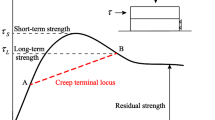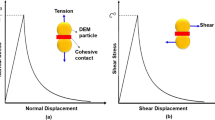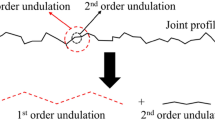Abstract
This paper aims to study the shear behaviour of rock joints in a direct shear test using the particle flow code PFC2D. In this numerical approach, the intact rock is simulated by densely packed circular particles that are bonded together at their contact points; joint surfaces can be explicitly simulated using the modified smooth joint (SJ) model. In the modified SJ model for simulation of direct shear test, micro-scale slip surfaces (smooth joint contacts) are applied at contacts between the particles of the upper and lower blocks of the shear box and the mechanical behaviour of the joints is controlled by the micro-scale properties of the smooth joint contacts. Two joint profiles of standard JRC 10–12 and a sawtooth triangular joint with a base angle of 15° were selected for testing. The results of direct shear tests under different normal stresses on these two profiles show that for the sawtooth triangular joints under a normal stress of 1 MPa, the shearing mechanism is purely sliding, and for the JRC 10–12 profile under a normal stress of 4 MPa, the shearing of first-order asperities controls the shearing mechanism. A parametric study of the micro-properties of the smooth joints under these two different shearing mechanisms was undertaken. The results of this study show that the SJ normal stiffness and the SJ shear stiffness have insubstantial effect on the peak shear strength in sliding mode, but that the SJ normal stiffness has a significant effect on the dilation rate in both sliding and shearing modes.

















Similar content being viewed by others
Abbreviations
- τ :
-
Shear stress
- \(\phi_{\text{r}}\) :
-
Residual friction angle
- JCS:
-
Joint compressive strength
- BPM:
-
Bonded particle model
- σ c :
-
Uniaxial compressive strength
- ν :
-
Poisson’s ratio
- δ peak :
-
Peak shear displacement
- M :
-
Damage coefficient
- R min :
-
Minimum particle radius
- F n :
-
Normal force
- U s :
-
Shear displacement
- E c :
-
Particle modulus
- k n :
-
Particle normal stiffness
- k s :
-
Particle shear stiffness
- μ c :
-
Particle coefficient of friction
- \(\hat{n}_{\text{j}}\) :
-
Normal unit vector of joint plane
- A :
-
Area of SJ cross section
- t :
-
Thickness of SJ
- \(\bar{k}_{\text{nj}}\) :
-
SJ normal stiffness
- \(\mu_{\text{j}}\) :
-
SJ coefficient of friction
- \(\psi_{\text{j}}\) :
-
SJ dilation angle
- \(F_{\text{s}}^{'}\) :
-
Updated shear force at SJ contact
- \(\Delta U_{\text{s}}^{\text{e}}\) :
-
Elastic portion of tangential displacement
- σ n :
-
Normal stress
- JRC:
-
Joint roughness coefficient
- SJ:
-
Smooth joint
- E :
-
Elastic modulus
- SD:
-
Standard deviation
- d n :
-
Peak dilation angle
- R :
-
Particle radius
- R max :
-
Maximum particle radius
- F s :
-
Shear force
- U n :
-
Normal displacement
- \(\bar{E}_{\text{c}}\) :
-
Parallel bond modulus
- \(\bar{k}^{\text{n}}\) :
-
Parallel bond normal stiffness
- \(\bar{k}^{\text{s}}\) :
-
Parallel bond shear stiffness
- Δ:
-
Increment
- \(\hat{t}_{\text{j}}\) :
-
Tangential unit vector of joint plane
- \(\bar{R}\) :
-
Radius of SJ
- \(\bar{\lambda }\) :
-
Radius multiplier of SJ
- \(\bar{k}_{sj}\) :
-
SJ shear stiffness
- \(\phi_{\text{j}}\) :
-
SJ friction angle
- \(F_{\text{s}}^{*}\) :
-
Greatest value of shear force at SJ contact
- \(\Delta U_{\text{n}}^{\text{e}}\) :
-
Elastic portion of normal displacement
References
Akram MS, Sharrock GB (2010) Physical and numerical investigation of a cemented granular assembly of steel spheres. Int J Numer Anal Methods Geomech 34:1896–1934
Asadi M, Rasouli V, Barla G (2012) A bonded particle model simulation of shear strength and asperity degradation for rough rock fractures. Rock Mech Rock Eng 45:649–675. doi:10.1007/s00603-012-0231-4
Asadi MS, Rasouli V, Barla G (2013) A laboratory shear cell used for simulation of shear strength and asperity degradation of rough rock fractures. Rock Mech Rock Eng 46:683–699. doi:10.1007/s00603-012-0322-2
Asadollahi P, Invernizzi MA, Addotto S, Tonon F (2010) Experimental validation of modified Barton’s model for rock fractures. Rock Mech Rock Eng 43:597–613. doi:10.1007/s00603-010-0085-6
Bahaaddini M (2014) Numerical study of the mechanical behaviour of rock joints and non-persistent jointed rock masses. PhD Dissertation, UNSW Australia
Bahaaddini M, Sharrock G, Hebblewhite B, Mitra R (2012) Direct shear tests to model the shear behaviour of rock joints by PFC2D. Paper presented at the 46th U.S. Rock Mechanics/Geomechanics Symposium, Chicago, IL
Bahaaddini M, Sharrock G, Hebblewhite BK (2013a) Numerical direct shear tests to model the shear behaviour of rock joints. Comput Geotech 51:101–115. doi:10.1016/j.compgeo.2013.02.003
Bahaaddini M, Sharrock G, Hebblewhite BK (2013b) Numerical investigation of the effect of joint geometrical parameters on the mechanical properties of a non-persistent jointed rock mass under uniaxial compression. Comput Geotech 49:206–225. doi:10.1016/j.compgeo.2012.10.012
Barton N (1973) Review of a new shear-strength criterion for rock joints. Eng Geol 7:287–332. doi:10.1016/0013-7952(73)90013-6
Barton N, Choubey V (1977) The shear strength of rock joints in theory and practice. Rock Mech 10:1–54. doi:10.1007/bf01261801
Byerlee JD (1967) Theory of friction based on brittle fracture. J Appl Phys 38:2928–2934
Cundall PA (2000) Numerical experiments on rough joints in shear using a bonded particle model. In: Aspects of tectonic faulting. Springer, Berlin, pp 1–9
Deisman N, Mas Ivars D, Darcel C, Chalaturnyk RJ (2010) Empirical and numerical approaches for geomechanical characterization of coal seam reservoirs. Int J Coal Geol 82:204–212. doi:10.1016/j.coal.2009.11.003
Esmaieli K, Hadjigeorgiou J, Grenon M (2010) Estimating geometrical and mechanical REV based on synthetic rock mass models at Brunswick Mine. Int J Rock Mech Min Sci 47:915–926
Esmaieli K, Hadjigeorgiou J, Grenon M (2013) Stability analysis of the 19A ore pass at Brunswick mine using a two-stage numerical modeling approach. Rock Mech Rock Eng 46:1323–1338. doi:10.1007/s00603-013-0371-1
Grasselli G (2006) Manuel rocha medal recipient-shear strength of rock joints based on quantified surface description. Rock Mech Rock Eng 39:295–314. doi:10.1007/s00603-006-0100-0
Grasselli G, Egger P (2003) Constitutive law for the shear strength of rock joints based on three-dimensional surface parameters. Int J Rock Mech Min Sci 40:25–40. doi:10.1016/S1365-1609(02)00101-6
Grasselli G, Wirth J, Egger P (2002) Quantitative three-dimensional description of a rough surface and parameter evolution with shearing. Int J Rock Mech Min Sci 39:789–800. doi:10.1016/S1365-1609(02)00070-9
Hadjigeorgiou J, Esmaieli K, Grenon M (2009) Stability analysis of vertical excavations in hard rock by integrating a fracture system into a PFC model. Tunn Undergr Space Technol 24:296–308. doi:10.1016/j.tust.2008.10.002
Handanyan JM, Danek ER, Andrea RAD, Sage JD (1990) The role of tension in failure of jointed rock. Paper presented at the Rock Joints: proceedings of a Regional Conference of the International Society for Rock Mechanics, Leon
Hudson JA, Harrison JP (1997) Engineering rock mechanics: an introduction to the principles. Pergamon, UK, Oxford
Indraratna B, Haque A (2000) Experimental and numerical modeling of shear behaviour of rock joints. Paper presented at the GeoEng 2000, an international conference on geotechnical and geological engineering, Melbourne
Itasca Consulting Group Inc (2008) PFC2D manual, version 4.0. Minneapolis
Jaeger JC (1971) Friction of rocks and stability of rock slopes. Géotechnique 21:97–134
Jing L, Stephansson O (2007) Fundamentals of discrete element methods for rock engineering: theory and applications. Elsevier, Amsterdam
Karami A, Stead D (2008) Asperity degradation and damage in the direct shear test: a hybrid FEM/DEM approach. Rock Mech Rock Eng 41:229–266. doi:10.1007/s00603-007-0139-6
Kodikara JK (1989) Shear behaviour of rock-concrete joints and side resistance of piles in weak rock. PhD Dissertation, Monash University
Kusumi H, Matsuoka T, Ashida Y, Tatsumi S (2005) Simulation analysis of shear behavior of rock joint by distinct element method. In: Eurock 2005—impact of human activity on geological environment. Taylor and Francis, London, pp 281–286
Ladanyi B, Archambault G (1969) Simulation of shear behavior of a jointed rock mass. Paper presented at the 11th US Rock Mechanics Symposium (USRMS), Berkeley
Ladanyi B, Archambault G (1980) Direct and indirect determination of shear strength of rock mass. Paper presented at the AIME annual meeting, Las Vegas
Leal-Gomes M, Dinis-da-Gama C (2010) Proposal for standardization of pull tests on rock joints. Int J Geomech 11:78–82. doi:10.1061/(asce)gm.1943-5622.0000072
Lee S (2003) Stability around underground openings in rock with dilative, non-persistent and multi-scale wavy joints using a discrete element method. PhD Dissertation, University of Illinois
Mas Ivars D, Pierce ME, Darcel C, Reyes-Montes J, Potyondy DO, Young RP, Cundall PA (2011) The synthetic rock mass approach for jointed rock mass modelling. Int J Rock Mech Min Sci 48:219–244. doi:10.1016/j.ijrmms.2010.11.014
Oh JM (2005) Three dimensional numerical modeling of excavation in rock with dilatant joints. PhD Dissertation, University of Illinois
Olsson R, Barton N (2001) An improved model for hydromechanical coupling during shearing of rock joints. Int J Rock Mech Min Sci 38:317–329. doi:10.1016/s1365-1609(00)00079-4
Park JW, Song JJ (2009) Numerical simulation of a direct shear test on a rock joint using a bonded-particle model. Int J Rock Mech Min Sci 46:1315–1328. doi:10.1016/j.ijrmms.2009.03.007
Park JW, Song JJ (2013) Numerical method for the determination of contact areas of a rock joint under normal and shear loads. Int J Rock Mech Min Sci 58:8–22. doi:10.1016/j.ijrmms.2012.10.001
Patton FD (1966) Multiple modes of shear failure in rock. Paper presented at the 1st ISRM Congress, Lisbon
Pierce M, Cundall P, Potyondy D, Mas Ivars D (2007) A synthetic rock mass model for jointed rock. Paper presented at the rock mechanics: meeting society’s challenges and demands, 1st Canada-U.S. Rock Mechanics Symposium, Vancouver
Potyondy DO, Cundall PA (2004) A bonded-particle model for rock. Int J Rock Mech Min Sci 41:1329–1364. doi:10.1016/j.ijrmms.2004.09.011
Rasouli V, Harrison JP (2010) Assessment of rock fracture surface roughness using Riemannian statistics of linear profiles. Int J Rock Mech Min Sci 47:940–948. doi:10.1016/j.ijrmms.2010.05.013
Saeb S, Amadei B (1992) Modelling rock joints under shear and normal loading. Int J Rock Mech Min Sci Geomech Abstracts 29:267–278. doi:10.1016/0148-9062(92)93660-C
Seidel JP (1993) The analysis and design of pile shafts in weak rock. PhD Dissertation, Monash University
Seidel JP, Haberfield CM (1995) The application of energy principles to the determination of the sliding resistance of rock joints. Rock Mech Rock Eng 28:211–226. doi:10.1007/bf01020227
Vosniakos K (2007) Physical and numerical modelling of shear behaviour of saw-toothed filled rock joint. PhD Dissertation, University of Manchester
Acknowledgments
The authors would like to acknowledge Dr. Glenn Sharrock, Dr. David Potyondy, Dr. Mathew Pierce, Dr. Xavier Garcia and Dr. Diego Mas Ivars from Itasca Consulting Group for their technical support and invaluable comments.
Author information
Authors and Affiliations
Corresponding author
Rights and permissions
About this article
Cite this article
Bahaaddini, M., Hagan, P.C., Mitra, R. et al. Parametric Study of Smooth Joint Parameters on the Shear Behaviour of Rock Joints. Rock Mech Rock Eng 48, 923–940 (2015). https://doi.org/10.1007/s00603-014-0641-6
Received:
Accepted:
Published:
Issue Date:
DOI: https://doi.org/10.1007/s00603-014-0641-6




